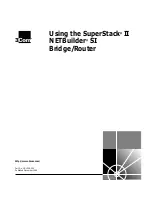
IP R
OUTING
17-30
Configuring the Routing Information Protocol
The RIP protocol is the most widely used routing protocol. The RIP
protocol uses a distance-vector-based approach to routing. Routes are
determined on the basis of minimizing the distance vector, or hop count,
which serves as a rough estimate of transmission cost. Each router
broadcasts its advertisement every 30 seconds, together with any updates
to its routing table. This allows all routers on the network to learn
consistent tables of next hop links which lead to relevant subnets.
Command Usage
• Just as Layer 2 switches use the Spanning Tree Algorithm to prevent
loops, routers also use methods for preventing loops that would cause
endless retransmission of data traffic. RIP utilizes the following three
methods to prevent loops from occurring:
- Split horizon – Never propagate routes back to an interface port from
which they have been acquired.
- Poison reverse – Propagate routes back to an interface port from
which they have been acquired, but set the distance-vector metrics to
infinity. (This provides faster convergence.)
- Triggered updates – Whenever a route gets changed, broadcast an
update message after waiting for a short random delay, but without
waiting for the periodic cycle.
• RIP-2 is a compatible upgrade to RIP. RIP-2 adds useful capabilities for
plain text authentication, multiple independent RIP domains, variable
A
1
3
6
4
2
5
B
C
D
E
A
A
B
C
D
Link
Cost
0
E
1
1
3
1
0
1
2
1
2
Cost = 1 for all links
Routing table for node A
Summary of Contents for WPCI-G - annexe 1
Page 2: ......
Page 26: ...TABLE OF CONTENTS xxvi ...
Page 36: ...GETTING STARTED ...
Page 72: ...MANAGING SYSTEM FILES 2 24 ...
Page 74: ...SWITCH MANAGEMENT ...
Page 90: ...CONFIGURING THE SWITCH 3 16 ...
Page 245: ...SHOWING PORT STATISTICS 8 33 Figure 8 12 Port Statistics ...
Page 252: ...ADDRESS TABLE SETTINGS 9 6 ...
Page 318: ...CLASS OF SERVICE 12 16 ...
Page 330: ...QUALITY OF SERVICE 13 12 ...
Page 348: ...DOMAIN NAME SERVICE 15 8 ...
Page 404: ...IP ROUTING 17 44 ...
Page 406: ...COMMAND LINE INTERFACE ...
Page 608: ...MIRROR PORT COMMANDS 26 4 ...
Page 644: ...SPANNING TREE COMMANDS 29 28 ...
Page 668: ...VLAN COMMANDS 30 24 ...
Page 686: ...CLASS OF SERVICE COMMANDS 31 18 ...
Page 700: ...QUALITY OF SERVICE COMMANDS 32 14 ...
Page 792: ...IP INTERFACE COMMANDS 36 50 ...
Page 818: ...APPENDICES ...
Page 824: ...SOFTWARE SPECIFICATIONS A 6 ...
Page 828: ...TROUBLESHOOTING B 4 ...
Page 844: ...INDEX Index 6 ...
Page 845: ......
















































